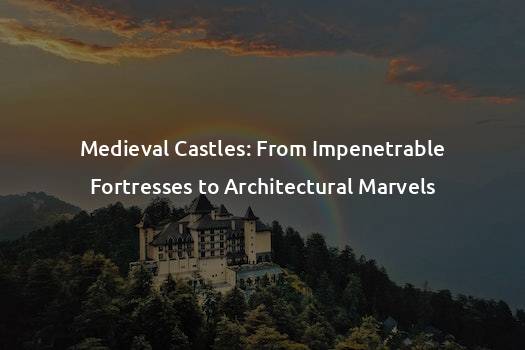Medieval Castles: From Impenetrable Fortresses to Architectural Marvels
Medieval Castles: From Impenetrable Fortresses to Architectural Marvels
During the medieval period, castles played a pivotal role in shaping the history of Europe. These magnificent structures served as both impressive fortifications and symbols of power, offering protection to the ruling classes and their subjects. Over the centuries, castles transformed from impregnable strongholds to awe-inspiring architectural marvels. Let’s take a journey through time and explore the fascinating evolution of medieval castles.
The Rise of Medieval Castles
The origins of medieval castles can be traced back to the 9th and 10th centuries when local lords and nobles began constructing simple fortified structures. These early castles were primarily built for defensive purposes, providing protection and refuge during times of war and conflict. Initially, they consisted of earthworks and palisades, but as warfare techniques advanced, so did castle construction.
Medieval castle design underwent a significant transformation in the 12th and 13th centuries. The emergence of stone masonry allowed for the creation of stronger and more elaborate fortresses. Architects and engineers incorporated defensive elements such as thick walls, battlements, drawbridges, and moats to deter potential attackers.
The Fortress Mentality
Castles during the feudal period were designed to withstand sieges and assaults. They were constructed on strategic locations, often atop hills or near water bodies. The strategic positioning ensured clear visibility of approaching enemies and made it difficult for assailants to infiltrate.
The walls of medieval castles were built thick and tall to provide formidable protection. The defenders could easily rain arrows, rocks, and boiling liquids upon invaders from the safety of the parapets. Moreover, battlements replete with crenellations offered cover for archers while still providing vantage points for offense. These features created a fortress mentality, emphasizing defense over aesthetics.
The Evolution of Castle Architecture
As the medieval period progressed, castles began to evolve beyond their primary defensive function. The ruling elites sought to display their power and wealth through impressive architecture. The transition from fortress to extravagant residence led to the emergence of castle palaces characterized by elegant living spaces, ornate furnishings, and lavish gardens.
The development of new building techniques and advancements in engineering allowed castle walls to become thinner and taller while maintaining their strength. The advent of pointed arches, ribbed vaults, and flying buttresses revolutionized castle architecture during the Gothic era. These innovations enabled the construction of larger windows and grand halls, transforming cold and dark fortresses into brighter and more comfortable dwellings.
The End of an Era
The decline of medieval castles commenced in the 15th century with the introduction of cannons and gunpowder. The thick walls and towering structures that once offered impenetrable defense became susceptible to destruction by artillery. Consequently, castles lost their military significance, and many fell into disrepair or were repurposed for the changing times.
However, the legacy of medieval castles remains innumerable. From their commanding presence on the landscape to their influence on architectural styles, castles have left an indelible mark on history. Today, many castles continue to stand as iconic landmarks, offering glimpses into the past and attracting tourists from around the world.
TL;DR
Medieval castles evolved from simple fortifications to stunning architectural marvels. Initially designed for defense, they featured thick walls, battlements, moats, and drawbridges. Over time, castles became grand residences showcasing the wealth and power of the ruling classes. The introduction of new construction techniques allowed for more comfortable living spaces. However, the advent of artillery marked the decline of castles as impregnable fortresses. Despite this, castles still serve as cultural and historical landmarks today.







